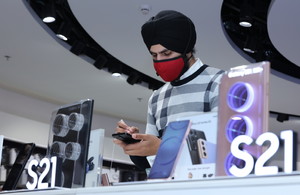
[이코노믹리뷰=노성인 기자] As smartphone shipments in China increased in January, a positive environment for domestic smartphone parts makers is expected to be created. The global smartphone market suffered a slump in the aftermath of Corona 19 last year, but from the beginning of the year, consumption is showing signs of a rebound.
According to data from the China Information and Communication Research Institute on the 13th, domestic smartphone shipments in China in January were 3.95 million units, up 94.3% from the same period last year. It is also a 56.9% increase from the previous month. January shipments are a number that exceeds the monthly average (27.55 million units) since April, and replacement demand for 5G (5G mobile communication) such as iPhone 12 accounted for a large proportion. In fact, 5G smartphone shipments out of total shipments increased 49.9% year-on-year to 2728 million units, accounting for 69% of the total shipments.
In January 2020, shipments (20.37 million units) decreased by more than 30% compared to the previous year due to the overall slowdown in domestic demand due to Corona 19 and supply disruptions caused by the shutdown of major factories. In addition to the base effect, the increase in shipments of Chinese local companies Oppo, Vivo, and Xiaomi, along with the reduction of Huawei’s business, is believed to have driven the rapid increase in shipments.
“In the case of China, considering the fact that the spread of Corona 19 began in earnest from February of last year, the increase is expected,” said Roh Gyeong-tak, a researcher at Yuanta Securities.
The US market is also expected to show a gradual recovery. According to counterpoint, a global market research firm, US smartphone sales in the fourth quarter of last year fell 6% compared to the same period last year, but increased 24% compared to the previous quarter.
This is interpreted as leading to an increase in overall smartphone sales in the US as major brands such as Samsung Electronics and Apple release new products one after another. Apple’s sales volume increased 14% year-on-year thanks to the launch of the iPhone 12, and Samsung Electronics also increased 5% thanks to the’Galaxy S20 Fan Edition (FE)’.
Counterpoint predicts that this trend will continue in the first quarter of this year. Jeff Field Hack, an analyst at Counterpoint Research, said, “The fourth quarter of last year was particularly difficult for mid- and low-end smartphone makers, but premium devices were relatively good.” It led to” analysis.
Considering the increase in smartphone shipments in China in January, concerns over the accumulated inventory burden are expected to be relieved. In particular, shipments are expected to continue to increase as major new smartphone models are scheduled to be released by smartphone makers in Greater China.

Researcher Roh said, “Amid the rapid decline in shipments of Huawei, aggressive shipments by manufacturers to account for the demand are expected to have a positive effect in the parts industry in the short term.” “With tight parts supply, the price hike of major parts and 5G It is expected that domestic parts makers will see an upcycle in earnings due to improved product mix and higher utilization rates as the proportion of smartphones increases.”
Hana Financial Investment Research Institute Kim Rok-ho said, “It is necessary to check whether the base effect continues through China’s shipments in February this year.” Will be seen.”
As a result, securities companies cited Samsung Electro-Mechanics (009150), PI Advanced Materials (178920), and Wisol (122990) as the stocks to receive related benefits.
Samsung Electro-Mechanics has the ability to supply MLCC (multilayer ceramic capacitors) for 5G smartphones, SiP packaging substrates used for communication modules and antenna modules, FPCB cables, and ultra-high frequency band antenna (mmWave AiP) modules. It is becoming a key vendor for phones.
PI Advanced Materials and Wisol are also expected to see full-fledged earnings improvement thanks to increased demand for their flagship products, polyimide (PI) film, surface acoustic wave (Saw) filter and volumetric acoustic wave (Baw) filter used in 5G antennas.
